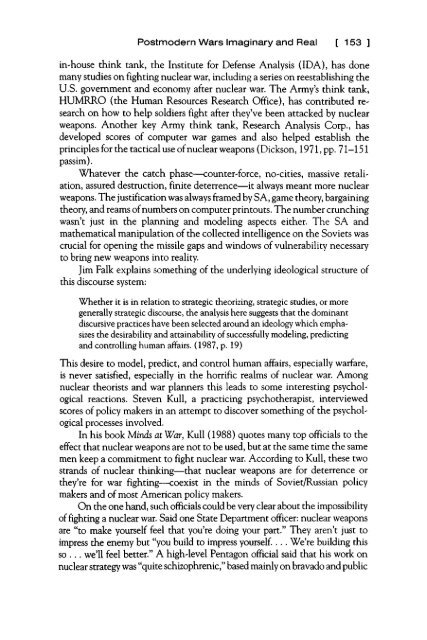entire book - Chris Hables Gray
entire book - Chris Hables Gray
entire book - Chris Hables Gray
You also want an ePaper? Increase the reach of your titles
YUMPU automatically turns print PDFs into web optimized ePapers that Google loves.
Postmodern Wars Imaginary and Real [ 153 ]<br />
in-house think tank, the Institute for Defense Analysis (IDA), has done<br />
many studies on fighting nuclear war, including a series on reestablishing the<br />
U.S. government and economy after nuclear war. The Army's think tank,<br />
HUMRRO (the Human Resources Research Office), has contributed research<br />
on how to help soldiers fight after they've been attacked by nuclear<br />
weapons. Another key Army think tank, Research Analysis Corp., has<br />
developed scores of computer war games and also helped establish the<br />
principles for the tactical use of nuclear weapons (Dickson, 1971,pp. 71-151<br />
passim).<br />
Whatever the catch phase—counter-force, no-cities, massive retaliation,<br />
assured destruction, finite deterrence—it always meant more nuclear<br />
weapons. The justification was always framed by SA, game theory, bargaining<br />
theory, and reams of numbers on computer printouts. The number crunching<br />
wasn't just in the planning and modeling aspects either. The SA and<br />
mathematical manipulation of the collected intelligence on the Soviets was<br />
crucial for opening the missile gaps and windows of vulnerability necessary<br />
to bring new weapons into reality.<br />
Jim Falk explains something of the underlying ideological structure of<br />
this discourse system:<br />
Whether it is in relation to strategic theorizing, strategic studies, or more<br />
generally strategic discourse, the analysis here suggests that the dominant<br />
discursive practices have been selected around an ideology which emphasizes<br />
the desirability and attainability of successfully modeling, predicting<br />
and controlling human affairs. (1987, p. 19)<br />
This desire to model, predict, and control human affairs, especially warfare,<br />
is never satisfied, especially in the horrific realms of nuclear war. Among<br />
nuclear theorists and war planners this leads to some interesting psychological<br />
reactions. Steven Kull, a practicing psychotherapist, interviewed<br />
scores of policy makers in an attempt to discover something of the psychological<br />
processes involved.<br />
In his <strong>book</strong> Minds at War, Kull (1988) quotes many top officials to the<br />
effect that nuclear weapons are not to be used, but at the same time the same<br />
men keep a commitment to fight nuclear war. According to Kull, these two<br />
strands of nuclear thinking—that nuclear weapons are for deterrence or<br />
they're for war fighting—coexist in the minds of Soviet/Russian policy<br />
makers and of most American policy makers.<br />
On the one hand, such officials could be very clear about the impossibility<br />
of fighting a nuclear war. Said one State Department officer: nuclear weapons<br />
are "to make yourself feel that you're doing your part." They aren't just to<br />
impress the enemy but "you build to impress yourself. ... We're building this<br />
so ... we'll feel better." A high-level Pentagon official said that his work on<br />
nuclear strategy was "quite schizophrenic," based mainly on bravado and public








